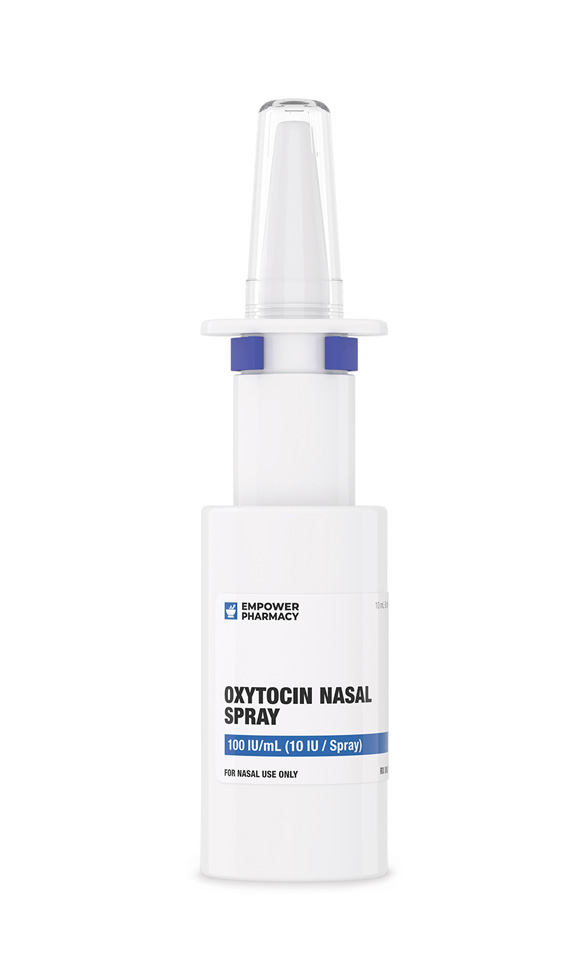- Description
- Reviews (0)
- Store Policies
- Inquiries
Description
Overview of Oxytocin Nasal Spray
-
Dosage Strengths of Oxytocin Nasal Spray
- 50 IU/mL (5 IU/Spray) 10 mL Nasal Spray Bottle
100 IU/mL (10 IU/Spray) 10 mL Nasal Spray Bottle
Endogenous oxytocin is a hormone secreted by the supraoptic and paraventricular nuclei of the hypothalamus and stored in the posterior pituitary. It stimulates contraction of uterine smooth muscle during gestation and causes milk ejection after milk has been produced in the breast. Oxytocin has been associated with mating, parental, and social behaviors. Oxytocin is released during intercourse in both men and women, which has led to the belief that it is involved in sexual bonding. There is speculation that in addition to facilitating lactation and the birthing process, the hormone facilitates the emotional bond between mother and child. Oxytocin has also been studied in autism and have some sort of relation to the social and developmental impairments associated with the disease. Clinically, oxytocin is used most often to induce and strengthen labor and control postpartum bleeding. Intranasal preparations of oxytocin, used to stimulate postpartum milk ejection, are no longer manufactured in the U.S. Oxytocin was approved by the FDA in 1962.
Synthetic oxytocin elicits the same pharmacological response produced by endogenous oxytocin, with cervical dilation, parity, and gestational age as predictors of the dose response to oxytocin administration for labor stimulation. Oxytocin increases the sodium permeability of uterine myofibrils, indirectly stimulating contraction of the uterine smooth muscle. The uterus responds to oxytocin more readily in the presence of high estrogen concentrations and with the increased duration of pregnancy. There is a gradual increase in uterine response to oxytocin for 20 to 30 weeks gestation, followed by a plateau from 34 weeks of gestation until term, when sensitivity increases. Women who are in labor have a greater response to oxytocin compared to women who are not in labor; only very large doses will elicit contractions in early pregnancy. In the term uterus, contractions produced by exogenous oxytocin are similar to those that would occur during spontaneous labor. Oxytocin increases the amplitude and frequency of uterine contractions, which transiently impede uterine blood flow and decrease cervical activity, causing dilation and effacement of the cervix.
Oxytocin causes contraction of the myoepithelial cells surrounding the alveolar ducts of the of the breast. This forces milk from the alveolar channels into the larger sinuses, and thus facilitates milk ejection. While oxytocin possesses no galactopoietic properties, if it is absent the milk-ejection reflex in the breast fails.
Oxytocin causes dilation of vascular smooth muscle, thus increasing renal, coronary, and cerebral blood flow. Blood pressure usually remains unaffected, but with the administration of very large doses or high concentration solutions blood pressure may decrease transiently. This transient decrease in blood pressure leads to reflex tachycardia and an increase in cardiac output; any fall in blood pressure is usually followed by a small, but sustained, increase in blood pressure.
Oxytocin does possess antidiuretic effects, but they are minimal. If oxytocin is administered with an excessive volume of electrolyte-free IV solution and/or at too rapid a rate, the antidiuretic effects are more apparent and water intoxication can result.
Oxytocin is indicated during pregnancy to induce labor; it precipitates uterine contractions and abortion.
Endogenous oxytocin is involved in the process of lactation and therefore, oxytocin has been used in mothers having difficulty with engorgement and breast-feeding. Because several small studies have failed to show a beneficial effect, oxytocin is not used for this indication. Oxytocin is excreted in the breast-milk, but is not expected to have adverse effects in the infant.4
Parenteral oxytocin should be used only by qualified professional personnel in a setting where intensive care and surgical facilities are immediately available. Furthermore, according to the manufacturer, oxytocin should only be used when induction of labor is necessary for medical reasons. It should not be used for elective induction of labor as available data are insufficient to evaluate the risk-benefit ratio in this indication. During oxytocin administration, uterine contractions, fetal and maternal heart rate, maternal blood pressure, and, if possible, intrauterine pressure should be continuously monitored to avoid complications. If uterine hyperactivity occurs, oxytocin administration should be immediately discontinued; oxytocin-induced stimulation of the uterine contractions usually decreases soon after discontinuance of the drug. The induction or continuance of labor with oxytocin should be avoided when the following conditions or situations are present: evidence of fetal distress, fetal prematurity, abnormal fetal position (including unengaged head), placenta previa, uterine prolapse, vasa previa, cephalopelvic disproportion, cervical cancer, grand multiparity, previous surgery of the uterus or cervix (including 2 or more cesarean deliveries), active genital herpes infection, or in any condition presenting as an obstetric emergency requiring surgical intervention. Use of oxytocin in any of these settings can aggravate the condition or cause unnecessary fetal or maternal distress.
Oxytocin may possess antidiuretic effects, and prolonged use can increase the possibility of an antidiuretic effect. Prolonged use of oxytocin and administration in large volumes of low-sodium infusion fluids are not recommended, particularly in patients with eclampsia or who have unresponsive uterine atony. Antidiuretic effects have the potential to lead to water intoxication and convulsive episodes due to hypertension.
Oxytocin is indicated during pregnancy to induce labor; it precipitates uterine contractions and abortion.
Endogenous oxytocin is involved in the process of lactation and therefore, oxytocin has been used in mothers having difficulty with engorgement and breastfeeding. Because several small studies have failed to show a beneficial effect, oxytocin is not used for this indication. Oxytocin is excreted in the breastmilk, but is not expected to have adverse effects in the infant.
In certain cases, oxytocin can be used in combination with other oxytocics for therapeutic purposes. There is a risk, however, of severe uterine hypertony occurring, with possible uterine rupture or cervical laceration. The concurrent use of dinoprostone, prostaglandin E2 and oxytocin is considered contraindicated; following the removal of the dinoprostone vaginal insert, an interval of at least 30 minutes is recommended prior to the use of another oxytocic agent. These products should be used sequentially only under adequate obstetric supervision.
Adverse cardiovascular effects can develop as a result of concomitant administration of oxytocin with general anesthetics or with spinal or epidural anesthetics, especially in those with preexisting valvular heart disease. Cyclopropane, when administered with or without oxytocin, has been implicated in producing maternal sinus bradycardia, abnormal atrioventricular rhythms, hypotension, and increases in heart rate, cardiac output, and systemic venous return. In addition, halothane decreases uterine responsiveness to oxytocics (e.g., oxytocin, ergonovine, methylergonovine) and, in high doses, can abolish it, increasing the risk of uterine hemorrhage. Halothane is a potent uterine relaxant. It is not clear if other halogenated anesthetics would interact with oxytocics in this manner.
The administration of prophylactic vasopressors with oxytocin can cause severe, persistent hypertension, as the 2 drugs may have a synergistic and additive vasoconstrictive effect. This interaction was noted when oxytocin was given 3—4 hours after prophylactic vasoconstrictor in conjuction with caudal anesthesia. The incidence of such an interaction may be decreased if vasopressors are not administered prior to oxytocin.6 This interaction can include certain other sympathomimetics such as ephedra, ma huang.
Do not take this medicine with any of the following medications:
- Ephedra, Ma Huang
This medicine may also interact with the following medications:
- dinoprostone, prostaglandin E2
- medicines for blood pressure
- medicines used for sleep during surgery
- other medicines to contract the uterus
This list may not describe all possible interactions. Give your health care provider a list of all the medicines, herbs, non-prescription drugs, or dietary supplements you use. Also tell them if you smoke, drink alcohol, or use illegal drugs. Some items may interact with your medicine.
Some patients can experience a hypersensitive uterine reaction to the effects of oxytocin. Excessive doses can have the same effect. This can produce increased, hypertonic uterine contractions, possibly prolonged, resulting in a number of adverse reactions such as cervical laceration, postpartum hemorrhage, pelvic hematoma, and uterine rupture.
Oxytocin-induced afibrinogenemia has been reported; it results in increased postpartum bleeding and can potentially be life-threatening. Neonatal retinal hemorrhage has been reported. Also, intracranial bleeding including subarachnoid hemorrhage has been reported in patients receiving oxytocin. In one case, subarachnoid hemorrhage mimicked acute water intoxication and delayed the diagnosis of hemorrhage after an oxytocin assisted labor.
Adverse maternal cardiovascular effects from oxytocin may include arrhythmia exacerbation, premature ventricular contractions (PVCs), and hypertension. In the fetus or neonate, fetal bradycardia, PVCs, and other arrhythmias have been noted.
Oxytocin has an antidiuretic effect, and severe and fatal water intoxication has been noted and may occur if large doses (40—50 milliunits/minute) are infused for long periods. For example, water intoxication with seizures and coma has occurred in association with a slow oxytocin infusion over a 24-hour period. Management of water intoxication includes immediate oxytocin cessation and supportive therapy. In the fetus or neonate, fetal death, permanent CNS or brain damage, and neonatal seizures have been noted with oxytocin. The rare complications of blurred vision, ocular hemorrhage (of the conjunctiva), and pulmonary edema have been associated with oxytocin induced water intoxication.
Oxytocin administration has been associated with anaphylactoid reactions.
Oxytocin-induced labor has been implicated in an increased incidence of neonatal hyperbilirubinemia, about 1.6 times more likely than after spontaneous labor. This can lead to neonatal jaundice.
Nausea and vomiting have been noted with oxytoxin.
Side effects that you should report to your doctor or health care professional as soon as possible:
- allergic reactions like skin rash, itching or hives, swelling of the face, lips, or tongue
- breathing problems
- excessive or continuing vaginal bleeding
- fast, irregular heartbeat
- feeling faint or lightheaded, falls
- high blood pressure
- seizures
- unusual bleeding or bruising
- unusual swelling, sudden weight gain
Side effects that usually do not require medical attention (report to your doctor or health care professional if they continue or are bothersome):
- headache
- nausea and vomiting.
This list may not include all possible adverse reactions or side effects. Call your health care provider immediately if you are experiencing any signs of an allergic reaction: skin rash, itching or hives, swelling of the face, lips, or tongue, blue tint to skin, chest tightness, pain, difficulty breathing, wheezing, dizziness, red, a swollen painful area/areas on the leg.
Store this medication at 68°F to 77°F (20°C to 25°C) and away from heat, moisture and light. Keep all medicine out of the reach of children. Throw away any unused medicine after the beyond use date. Do not flush unused medications or pour down a sink or drain.
1.Cabanac M, Pfaff DW, Ogawa S, et al. Neural oxytocinergic systems as genomic targets for hormones and as modulators of hormone-dependent behaviors. Results Probl Cell Differ 1999;26:91-105.
2.Modahl C, Green L, Fein D, et al. Plasma oxytocin levels in autistic children. Biol Psychiatry 1998;43:270-277.
3.American College of Obstetrics and Gynecology (ACOG). ACOG Practice Bulletin Number 10: Clinical Management Guidelines for Obstetrician-Gynecologists. Induction of labor. Washington, DC: American College of Obstetricians and Gynecologists; November 1999.
4.Mangesi L, Dowswell T. Treatments for breast engorgement during lactation. Cochrane Database Syst Rev. 2010;9:CD006946.
5.Cervidil® (dinoprostone vaginal insert) package insert. St. Louis, MO: Forest Laboratories, Inc.; 1997 Jul.
6.Pitocin® (oxytocin injection, USP) package insert. Rochester, MI: Monarch Pharmaceuticals; 2003 Jan.
7.Halothane, USP package insert. North Chicago, IL: Abbott Laboratories; 1998 Mar.
8.Pitocin (oxytocin) package insert. Rochester, MI: JHP Pharmaceuticals, LLC; 2014 Sept.
9.Curless RV, Beaumont DM, Sinar EJ, et al. Subarachnoid hemorrhage mimicking acute water intoxication during labour augmented by oxytocin infusion. Br J Clin Pract 1990;44(12):637-638.
Be the first to review “Oxytocin Nasal Spray”
General Inquiries
There are no inquiries yet.










Reviews
There are no reviews yet.